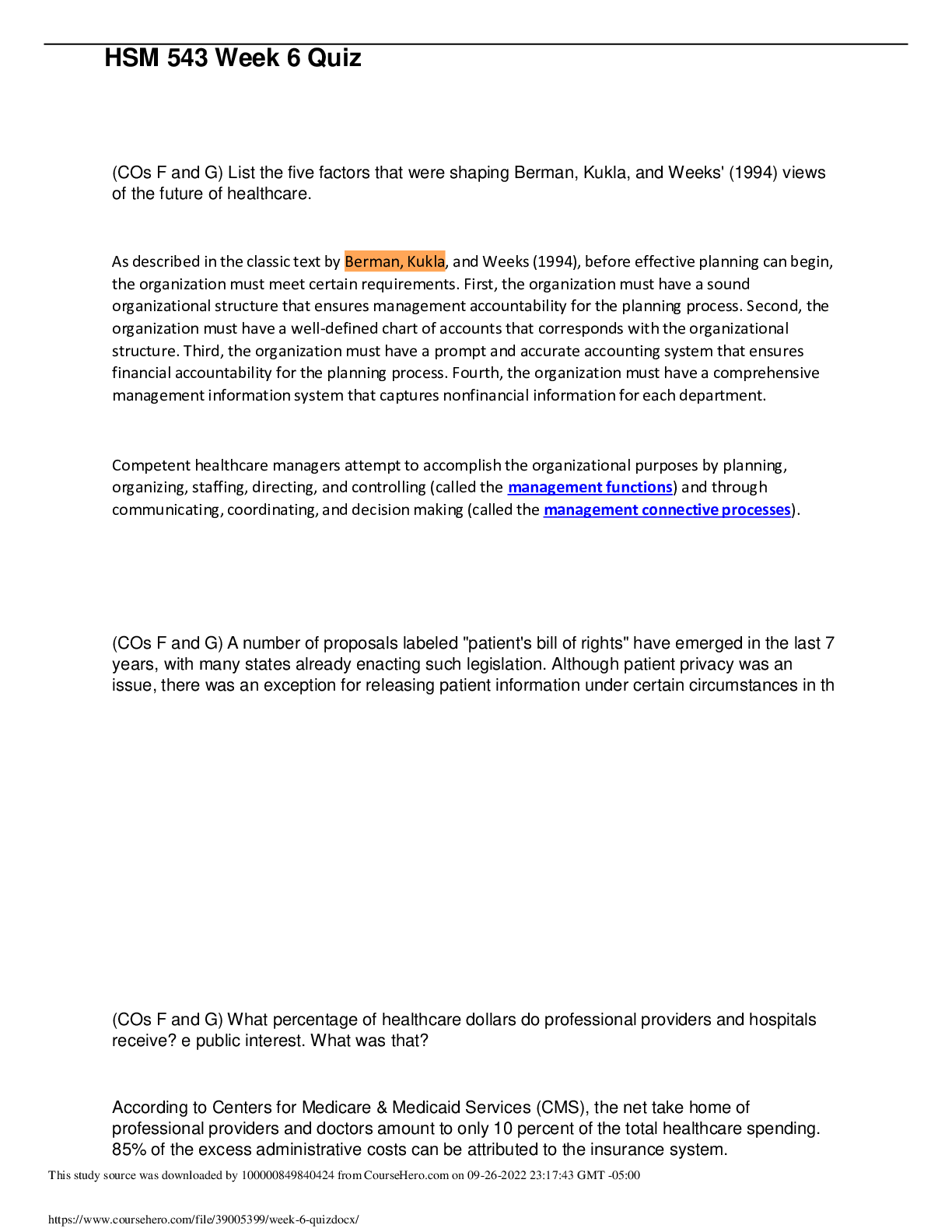Anatomy > EXAM > Chapter 26 RENAL SYSTEM (RATED A+) Questions & Answers Solutions | Download To Score An A (All)
Chapter 26 RENAL SYSTEM (RATED A+) Questions & Answers Solutions | Download To Score An A
Document Content and Description Below
Chapter 26 Renal System 1) The urinary system does all of the following, except that it A) Secretes excess glucose molecules. B) Eliminates organic waste products. C) Regulates plasma concentrat... ions of electrolytes. D) Contributes to stabilizing blood pH. E) Regulates blood volume. 2) Urine is produced by the A) Urethra. B) Ureter. C) Urinary bladder. D) Liver. E) Kidney. 3) Urine is carried to the urinary bladder by A) The ureters. B) Blood vessels. C) Lymphatics. D) The calyces. E) The urethra. 4) Each of the following organs is part of the urinary system, except the A) Urethra. B) Urinary bladder. C) Kidney. D) Liver. E) Ureter. 5) All of the following are true of the kidneys, except that they are A) Held in place by the renal fascia. B) Surrounded by a renal capsule. C) Surrounded by a thick layer of adipose tissue. D) Located within the peritoneum. E) Located in a position that is retroperitoneal. 6) The prominent indentation on the medial surface of the kidney is the A) Pelvis. B) Hilus. C) Calyx. D) Pyramid. E) Ureter. 7) The renal sinus is A) An internal cavity lined by the fibrous capsule and located in the area of the hilus. B) A large branch of the renal pelvis. C) The innermost layer of kidney tissue. D) A knot of capillaries that lies within the renal corpuscle. E) A conical structure that is located in the renal medulla. 8) The outermost layer of kidney tissue is the A) Minor calyx. B) Renal cortex. C) Renal medulla. D) Renal pelvis. E) Major calyx. 9) The innermost layer of kidney tissue is the A) Renal pelvis. B) Renal medulla. C) Major calyx. D) Minor calyx. E) Renal cortex. 10) Conical structures that are located in the renal medulla are called A) Pyramids. B) Renal pelvises. C) Renal columns. D) Nephrons. E) Calyces. 11) Renal columns are A) Internal cavities lined by the fibrous capsule and located in the area of the hilus. B) Expanded ends of the ureters. C) The basic functional units of the kidney. D) Conical structures that is located in the renal medulla. E) Bundles of tissue that lie between pyramids and extend from the renal cortex toward the renal sinus. 12) The expanded end of the ureter forms the A) Renal corpuscle. B) Renal hilus. C) Renal calyx. D) Renal pelvis. E) Renal sinus. 13) Major calyces are A) Expanded ends of nephrons. B) The expanded ends of renal pyramids. C) Conical structures that is located in the renal medulla. D) Large branches of the renal pelvis. E) Basic functional layers of the kidney. 14) Bowman's capsule and the glomerulus make up the A) Renal papille B) Renal corpuscle. C) Loop of Henle. D) Renal pyramid. E) Collecting tubule system. 15) The region known as the macula densa is part of A) The proximal convoluted tubule. B) The distal convoluted tubule. C) The loop of Henle. D) The collecting duct. E) Bowman's capsule. 16) The cells of the macula densa and the juxtaglomerular cells form the A) Renal corpuscle. B) Loop of Henle. C) Afferent arteriole. D) Filtration membrane. E) Juxtaglomerular apparatus. 17) The expanded end of a nephron is the A) Distal convoluted tubule. B) Loop of Henle. C) Glomerulus. D) Proximal convoluted tubule. E) Renal corpuscle. 18) A glomerulus is A) The portion of the nephron that attaches to the collecting duct. B) The horseshoe-shaped segment of the nephron. C) A knot of capillaries that lies within the renal corpuscle. D) The portion of the nephron closest to the renal corpuscle. E) The expanded end of a nephron. 19) The portion of the nephron closest to the renal corpuscle is the A) Loop of Henle. B) Collecting duct. C) Distal convoluted tubule. D) Minor calyx. E) Proximal convoluted tubule. 20) The portion of the nephron that attaches to the collecting duct is the A) Proximal convoluted tubule. B) Collecting duct. C) Minor calyx. D) Loop of Henle. E) Distal convoluted tubule. 21) The horseshoe-shaped segment of the nephron is the A) Minor calyx. B) Loop of Henle. C) Proximal convoluted tubule. D) Distal convoluted tubule. E) Collecting duct. 22) The primary function of the proximal convoluted tubule is A) Secretion of acids and ammonia. B) Filtration. C) Secretion of drugs. D) Absorption of ions, organic molecules, vitamins, and water. E) Adjusting the urine volume. 23) The following is a list of the blood vessels that carry blood to the kidney. 1. afferent arteriole 2. arcuate artery 3. interlobar artery 4. renal artery 5. glomerulus 6. interlobular artery 7. efferent arteriole 8. peritubular capillary The proper order in which blood passes through these vessels is A) 4, 6, 2, 3, 1, 5, 7, 8. B) 4, 3, 2, 6, 7, 5, 1, 8. C) 4, 3, 2, 6, 1, 5, 7, 8. D) 4, 3, 6, 2, 1, 5, 7, 8. E) 4, 6, 2, 3, 7, 5, 1, 8. 24) The process of filtration occurs at A) The distal convoluted tubule. B) The Bowman's capsule. C) The loop of Henle. D) The collecting duct. E) The proximal convoluted tubule. 25) Each of the following is a characteristic of a normal urine sample, except A) Amber color. B) Ammoniacal odor. C) Specific gravity greater than 1.0. D) Acidic pH. E) Cloudy. 26) Each of the following is a normal constituent of urine, except A) Hydrogen ions. B) Urea. C) Large proteins. D) Creatinine. E) Salts. 27) The most selective pores in the filtration membrane are located in the A) Podocytes. B) Capillary endothelium. C) Lamina densa. D) Basement membrane of the capillaries. E) Capsular space. 28) Substances larger than are normally not allowed to pass through the filtration membrane. A) sodium ions B) glucose C) albumin D) urea E) amino acids 29) Sympathetic stimulation of the kidney can accomplish all of the following, except A) Produce renal ischemia. B) Result in the release of renin. C) Increase the glomerular filtration rate. D) Produce powerful vasoconstriction of the afferent arterioles. E) both C and D 30) The process of filtration is driven by A) Active transport. B) Renal pumping. C) Solvent drag. D) Blood hydrostatic pressure. E) Blood osmotic pressure. 31) The ability to form a concentrated urine depends on the functions of A) The proximal convoluted tubule. B) The loop of Henle. C) The distal convoluted tubule. D) The collecting duct. E) Bowman's capsule. 32) Tubular reabsorption involves all of the following, except A) Countertransport. B) Active transport. C) Facilitated diffusion. D) Cotransport. E) Cuboidal cell filtration. 33) When the concentrations of glucose and amino acids are relatively high in the filtrate, they are reabsorbed by the process of A) Countertransport. B) Facilitated diffusion. C) Cotransport. D) Active transport. E) Diffusion. 34) Magnesium iodide and iron ions are reabsorbed by the process of A) cotransport. B) diffusion. C) active transport. D) Countertransport. E) Facilitated diffusion. 35) When the concentration of glucose and amino acids is relatively low in the filtrate, they are reabsorbed by the process of A) Facilitated diffusion. B) Cotransport. C) Countertransport. D) Diffusion. E) Active transport. 36) Chloride and hydrogen ions are moved across the tubular membrane by the process of A) cotransport. B) facilitated diffusion. C) active transport. D) diffusion. E) Countertransport. 37) The cells of the proximal convoluted tubule normally reabsorb all of the following, except A) Approximately 60 percent of the volume of the filtrate produced in the renal corpuscle. B) Cations such as sodium, calcium, and magnesium. C) Anions such as bicarbonate, chloride, sulfate, and phosphate. D) Approximately 50 percent of the waste products. E) Virtually all of the glucose and other nutrients under normal conditions. 38) Substances secreted by the distal convoluted tubule include A) Creatinine. B) Penicillin. C) Hydrogen and potassium ions. D) all of the above E) A and C only 39) The role of "countercurrent multiplication" in the kidney is to A) Produce a glucose gradient that will facilitate the reabsorption of glucose. B) Actively pump water from the nephron into the renal medulla. C) Produce a salt gradient that will allow the kidney to retain salt ions. D) Produce a urea gradient that will promote the diffusion of urea into the collecting duct. E) Produce a concentration gradient that will allow the nephron to produce a hypotonic filtrate. 40) When the level of ADH (antidiuretic hormone) increases, A) Less water is reabsorbed by the nephron and collecting duct. B) Less urine is produced. C) More salt is secreted by the nephron. D) The specific gravity of the urine decreases. E) More urine is produced. 41) In response to increased levels of aldosterone, the kidneys produce A) Urine with a lower concentration of potassium ions. B) Urine with less urea. C) Urine with a lower specific gravity. D) Urine with a higher concentration of sodium ions. E) A larger volume of urine. 42) The ureters and urinary bladder are lined by epithelium. A) pseudostratified columnar B) simple cuboidal C) stratified squamous D) simple columnar E) transitional 43) The detrusor muscle A) Is located in the renal pelvis. B) Compresses the urinary bladder and expels urine through the urethra. C) Functions as the internal urinary sphincter. D) Functions as the external urinary sphincter. E) Moves urine through the ureters. 44) During the micturition reflex, A) Stimulation of stretch receptors in the bladder wall results in afferent impulses arriving in the lumbar region of the spinal cord. B) The external sphincter relaxes as the result of a parasympathetic reflex. C) The internal sphincter must be consciously relaxed. D) There is increased activity of the parasympathetic motor neurons that control the smooth muscle of the bladder. E) both C and D 45) Changes that occur in the urinary system with aging include all of the following, except A) A decline in the number of functional nephrons. B) Problems with the micturition reflex. C) Increased sensitivity to ADH. D) A reduction in the GFR (glomerular filtration rate). E) Loss of sphincter muscle tonus. 46) Each of the following systems of the body is involved in the process of excretion to some degree, except the system. A) integumentary B) respiratory C) endocrine D) digestive E) urinary 47) The body has kidney(s). A) 1 B) 2 C) 3 D) 4 E) none of the above 48) Functions of the urinary system include A) Conservation of valuable nutrients. B) Helping to stabilize blood pH. C) Regulation of blood volume and blood pressure. D) Regulation of plasma concentration of certain ions. E) all of the above 49) The left kidney lays to the right kidney. A) transverse B) posterior C) inferior D) superior E) both A and C 50) The positioning of the kidneys in the abdominal cavity is maintained by A) The overlying peritoneum. B) Supporting connective tissues. C) Contact with adjacent visceral organs. D) none of the above E) A, B, and C 51) The condition called is especially dangerous because the ureters or renal blood vessels can become twisted or kinked during movement. A) polycystic kidney disease B) kidney stones C) pyelonephritis D) floating kidney E) both B and C 52) A typical adult kidney weighs about A) 150 g. B) 5.25 ounces. C) 2 lb. D) both A and B E) both B and C 53) In normal, healthy individuals, each minute. A) 500 B) 800 C) 1200 D) 1800 E) 2500 ml of blood flows through the kidneys 54) Proximal convoluted tubule is to as distal convoluted tubule is to . A) variable reabsorption of water, sodium, and calcium; reabsorption of water, ions, and organic nutrients B) reabsorption of water, ions, and organic nutrients; secretion of ions, acids, drugs, and toxins C) production of filtrate; reabsorption of water, ions, and organic nutrients D) secretion of ions, acids, drugs, and toxins; variable reabsorption of water, sodium, and calcium ions E) none of the above 55) The is responsible for the delivery of urine to the minor calyx. A) ureter B) renal corpuscle C) loop of Henle D) distal convoluted tubule E) papillary duct 56) The filtration of plasma is primarily the function of the A) Renal corpuscle. B) Papillary duct. C) Distal convoluted tubule. D) Loop of Henle. E) Ureter. 57) The loop of Henle is made up of cells. A) squamous B) low cuboidal C) columnar D) both A and B E) both B and C 58) The kidneys not only remove waste products from the blood, they also assist in the regulation of A) Blood volume. B) Blood pressure. C) Blood pH. D) Blood ion levels. E) all of the above 59) is an inflammatory disorder of the glomeruli that affects the filtration mechanism of the kidneys. A) Floating kidney B) Glomerulonephritis. C) Pyelonephrosis D) Polycystic kidney disease E) Kidney stones 60) Glomerulonephritis occurs as a result of the bacterium A) varicella. B) Streptococcus. C) Clostridium difficile. D) MRSA. E) none of the above 61) In the kidney tubules, all of the following are reabsorbed except A) Calcium. B) Chloride. C) Sodium. D) Hydrogen. E) Potassium. 62) The renal threshold for glucose is approximately mg/dl. A) 75 B) 90 C) 100 D) 140 E) 180 63) Angiotensin II is an active hormone-like peptide that primarily affects A) The CNS. B) Adrenal glands. C) Nephrons. D) Peripheral capillary beds. E) all of the above 64) Roughly liters of fluid are produced by the glomeruli each day. A) 40 B) 80 C) 130 D) 180 E) 210 65) is an inherited abnormality that affects the development and structure of kidney tubules. A) Polycystic kidney disease B) Hematuria C) Calculus D) Renal failure E) Glomerulonephritis 66) Drugs that promote fluid loss in urine are known as A) Diuretics. B) Beta blockers. C) Calcium channel blockers. D) SSRIs. E) Alpha-1 antagonists. 67) An inability of the kidneys to secrete wastes in sufficient amounts to maintain homeostasis will lead to A) Glomerulonephritis. B) Renal failure. C) Hematuria. D) Calculi. E) Polycystic kidney disease. 68) The layer of collagen fibers covering the outer surface of the entire kidney is the A) Renal capsule. B) adipose capsule. C) Renal fascia. D) adrenal fascia. E) Renal cortex. 69) The glomerulus is located within the A) Renal capsule. B) Renal tubule. C) Renal colmun. D) Renal pelvis. E) Renal corpuscle. 70) The majority of nephrons are located in the of the kidney. A) vasa recta B) medulla C) calyces D) pelvis E) cortex 71) The urinary system regulates blood volume and pressure by A) Releasing renin. B) Adjusting the volume of water lost in urine. C) Releasing erythropoietin. D) A, B, and C E) none of the above 72) Characteristics of carrier-mediated transport processes include A) A carrier protein that can bind a wide variety of substances. B) A carrier protein that normally can move materials in either direction across the membrane. C) No saturation point. D) A variable distribution of carrier proteins from one portion of the cell surface to another. E) A distribution of only one type of carrier in any one cell membrane. 73) A pyelogram can be used to detect all of the following, except A) Obstruction of the ureters. B) Kidney stones. C) High blood pressure in the glomerulus. D) Tumors or growths in the urinary bladder. E) Structural abnormalities of the kidney. 74) Damage to the renal medulla would interfere first with the functioning of which of the following? A) proximal convoluted tubule B) glomerulus C) collecting ducts D) Bowman's capsule E) distal convoluted tubule 75) An obstruction in the glomerulus would affect the flow of blood into the A) Intralobular artery. B) Efferent arteriole. C) Afferent arteriole. D) Renal artery. E) none of the above 76) Measurement of the functions of a nephron reveals a glomerular pressure of 69 mm Hg, and a pressure in the capsular space of 15 mm Hg. Assuming that the plasma osmotic pressure is 30 mm Hg, and that essentially no plasma proteins are filtered by the glomerulus, what is the net glomerular filtration pressure in this case? A) -6 mm Hg B) 24 mm Hg C) 54 mm Hg D) 84 mm Hg E) 114 mm Hg 77) In the loop of Henle A) The ascending limb is very permeable to water. B) The filtrate in the descending limb becomes more and more hypotonic. C) Water osmoses into the descending limb. D) Sodium and chloride ions are actively transported out of the ascending limb. E) Filtrate is produced. 78) Urea is A) Completely eliminated in the urine. B) Actively reabsorbed in the proximal convoluted tubule. C) Actively transported into the filtrate by the cells of the collecting duct. D) Passively reabsorbed in the proximal convoluted tubule. E) Actively secreted in the distal convoluted tubule. 79) The mechanisms for maintaining the solute concentration gradient in the renal medulla require A) The vasa recta to be impermeable to water. B) Active transport of sodium and chloride ions from the ascending limb of the vasa recta. C) The ascending limb of the loop of Henle to be permeable to water. D) Active transport of sodium and chloride ions from the ascending limb of the loop of Henle. E) both A and B 80) Which of the following is greater? A) the concentration of solute in the filtrate at the bottom of the descending limb of the loop of Henle B) the concentration of solute in the filtrate at the beginning of the loop of Henle 81) Which of the following is greater? A) facultative reabsorption when the body is hydrated B) facultative reabsorption when the body is dehydrated 82) The antidiuretic hormone A) Is sensitive to changes in the blood concentrations of both sodium and potassium. B) Causes the kidneys to produce a larger volume of relatively solute-free urine. C) Is secreted in response to low concentrations of potassium ions in the extracellular fluid. D) Helps regulate the concentration of sodium ion in the interstitial space. E) Increases the permeability of the collecting ducts to water. 83) If a freshly voided urine sample is very dark in color, which of the following will be true? A) It will contain excess hydrogen ion. B) It will have the odor of ammonia. C) Its pH is below normal. D) It will contain excess sodium ion. E) It will contain large amounts of urochrome. 84) If an injury reduces blood flow to the kidneys, which of the following will occur? A) The amount of ADH in the blood will decrease. B) Sodium reabsorption will be inhibited. C) Obligatory water reabsorption will decrease. D) There will be systemic vasodilation. E) Aldosterone secretion will increase. 85) In response to high plasma osmolarity, A) The osmolarity of the urine will decrease. B) There is an increased permeability of the membrane of the renal collecting ducts to water. C) There is an increased transport of sodium ions from the lumen of the collecting duct into the renal medulla. D) Secretion of ADH is suppressed. E) The vasa recta carry the extra solute into the medulla of the kidney, where it diffuses into the interstitial space. 86) Urine is temporarily stored in the . A) Urinary Bladder B) Kidney C) Ureter D) Urethra 87) Urine is carried from the urinary bladder to the outside of the body by the . A) Ureter B) Uterus C) Urethra 88) Most nephrons are , which are located in the superficial cortex and have small loops of Henle. A) Cortical B) Medullary C) Juxtamedullary 89) Nephrons located close to the medulla with loops of Henle that extend deep into the renal pyramids are called . A) Cortical B) Medullary C) Juxtamedullary 90) The is a capillary that surrounds the loop of Henle of the Juxtamedullary nephron. A) Vasa recta B) Rectum C) Peritubular capillaries 91) The concentration at which all of the carriers for a given substance are saturated is the . A) Tubular maximum or Tm B) Tubular minimum C) Tubular intermediate 92) The is the plasma concentration at which a specific compound will begin appearing in the urine. A) Renal threshold B) Renal clearance C) Renal secretion 93) The filtration pressure at the glomerulus is equal to . A) Blood hydrostatic pressure – capsular hydrostatic pressure – blood osmotic pressure B) Blood hydrostatic pressure + capsular hydrostatic pressure – blood osmotic pressure C) Blood hydrostatic pressure – capsular hydrostatic pressure + blood osmotic pressure D) Blood hydrostatic pressure + capsular hydrostatic pressure + blood osmotic pressure 94) The amount of filtrate produced by the kidneys each minute is the . A) GFR B) GRF C) RGF D) FGR 95) The process of involves a carrier protein that can transport a molecule along its concentration gradient without the expenditure of cellular energy. A) Facilitated diffusion B) Facilitated secretion C) Facilitated excretion 96) A transport mechanism that can move a substance against a concentration gradient by using cellular energy is . A) Active transport B) Passive transport 97) In the process of two substances are moved across a cell membrane in the same direction without directly using cellular energy. One of the substances can be moved against a concentration gradient by this process. A) Cotransport B) Countertransport C) Antiporter D) B and C E) A, B, and C 98) The area of the urinary bladder bounded by the openings of the two ureters and the Urethra is called the . A) Trigone B) Triangular C) Trapezoid 99) is the blood pressure in the glomerular capillaries. A) Glomerular hydrostatic pressure B) Capsular hydrostatic pressure C) Blood oncotic pressure 100) The test is often used to determine the glomerular filtration rate. A) Creatinine clearance B) Glucose clearance C) Amino acid clearance 101) Glomerulonephritis is an immune complex disorder. A) False B) True 102) The glomerular hydrostatic pressure is significantly lower than the pressure in the rest of the systemic circuit. A) True B) False 103) Frank has been fasting for several days and he begins to notice a strong smell of ammonia in his urine. He begins to worry and borrows some pH paper from the chemistry lab and finds that his urine is also very acidic. What could account for these observations? Answer Frank's fasting has resulted in his body utilizing proteins and fats as a source of energy since carbohydrate sources of energy are not readily available. Metabolism of these nutrients produces acidic products such as lactic acid and ketone bodies. The amount of these substances, as well as mobilized fatty acids, exceeds their tubular maximum and the excess is excreted in the urine. The presence of these substances in the plasma also shifts the pH to be lower, prompting the kidneys to secrete more hydrogen ions. Since hydrogen ion secretion is dependent on the pH of the filtrate (among other things), the filtrate must be buffered to accept the extra ions. The body conserves base in the form of bicarbonate, so it produces ammonia, which can accept hydrogen ions in the filtrate to form ammonia and thus buffer the filtrate while conserving bicarbonate. This accounts for the heavy ammonia smell of Frank's urine. 104) Physicians often ask for urine samples collected over a 24-hour period, rather than a single sample. Why? Answer A single sample is useful in detecting the presence or absence of specific solutes (such as glucose), but it is less useful in detecting the amount of fluid lost via urination or the amount of some substances, such as urea or creatinine, lost per day. The amount of water reabsorbed from the filtrate can change from moment to moment, making the concentration in any one sample variable. The concentration of a solute in a single sample is much more variable than the amount excreted in a 24-hour period. 105) Randy enjoys his four or five cups of coffee a day and his six or seven beers a few nights a week. What are the effects of his caffeine and alcohol consumption on his urinary system? Answer Caffeine increases the glomerular filtration rate by increasing blood flow into the glomerular capillaries. The increase in filtrate formation and in the rate of flow through the renal tubule reduces the time available for the reabsorption of solutes. The alcohol acts as a diuretic, inhibiting ADH secretion and resulting in excess loss of water by the formation of dilute urine. The resulting dehydration leads to decreased secretion by body glands, including the salivary glands, which makes the mouth dry. 106) For the past week, Susan has felt a burning sensation in the urethral area when she urinates. She checks her temperature and finds that she has a low-grade fever. What unusual substances are likely to be present in her urine? Answer Susan may have a urinary tract infection (UTI), so her urine is likely to contain blood cells and bacteria. 107) Carlos has advanced arteriosclerosis. An analysis of his blood indicates elevated levels of aldosterone and decreased levels of ADH. Explain. Answer Arteriosclerosis contributes to hypertension (high blood pressure), which would trigger a baroreceptor reflex that would lead to a decrease in the level of ADH in the blood. Assuming that the arteriosclerosis is affecting all of Carlos's large arteries, including the renal arteries, the stiffening of the vessels would decrease the blood flow to the kidneys, thus triggering the release of renin from the juxtaglomerular apparatus. The renin would catalyze the conversion of angiotensinogen into angiotensin I, and the angiotensin I would be converted into angiotensin II at the lungs. The angiotensin II would stimulate the secretion of aldosterone, which would increase sodium and water reabsorption, thus increasing blood volume. The increase in blood volume would add to the hypertension, further decreasing the levels of ADH. [Show More]
Last updated: 1 year ago
Preview 1 out of 16 pages
.png)
Reviews( 0 )
Document information
Connected school, study & course
About the document
Uploaded On
Jan 17, 2022
Number of pages
16
Written in
Additional information
This document has been written for:
Uploaded
Jan 17, 2022
Downloads
0
Views
38






.png)










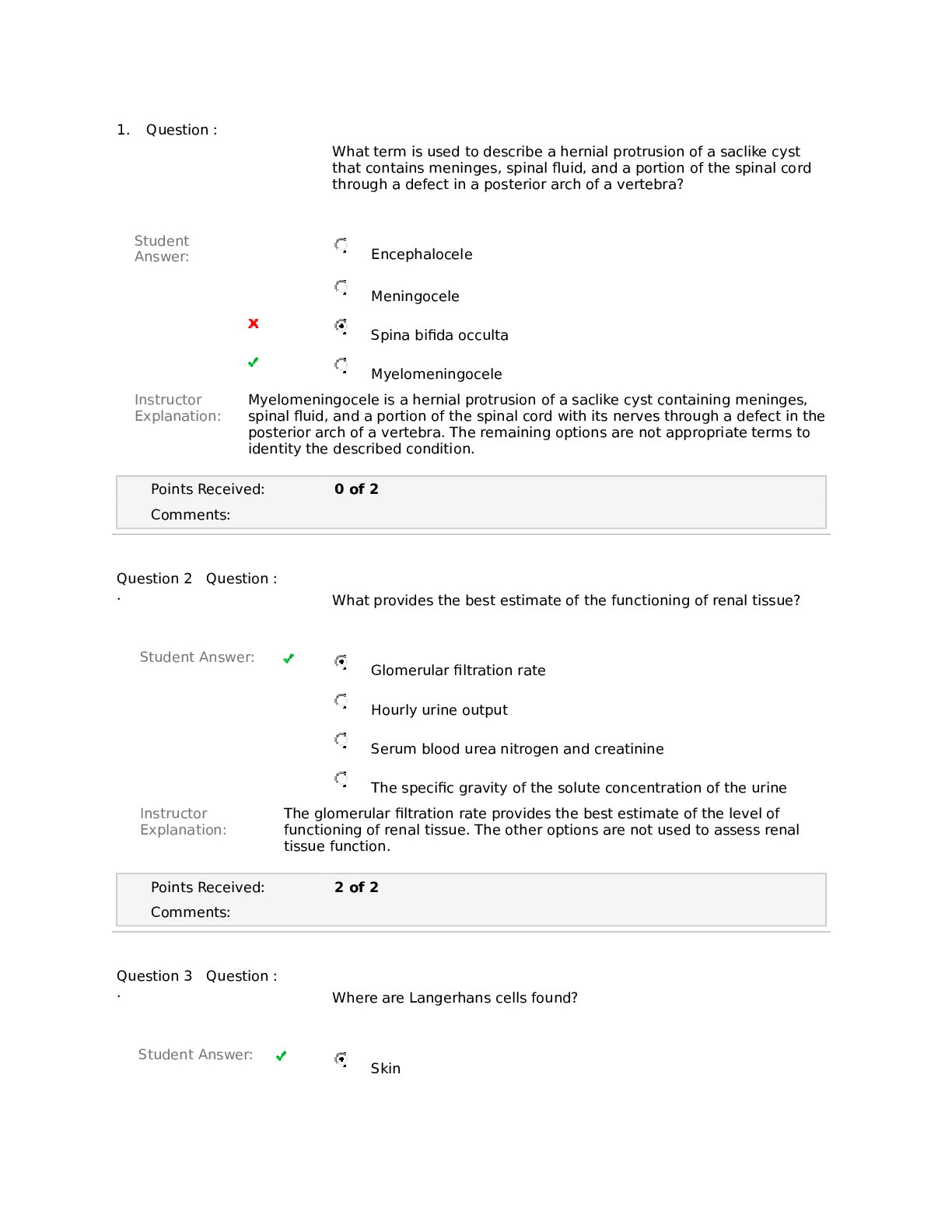
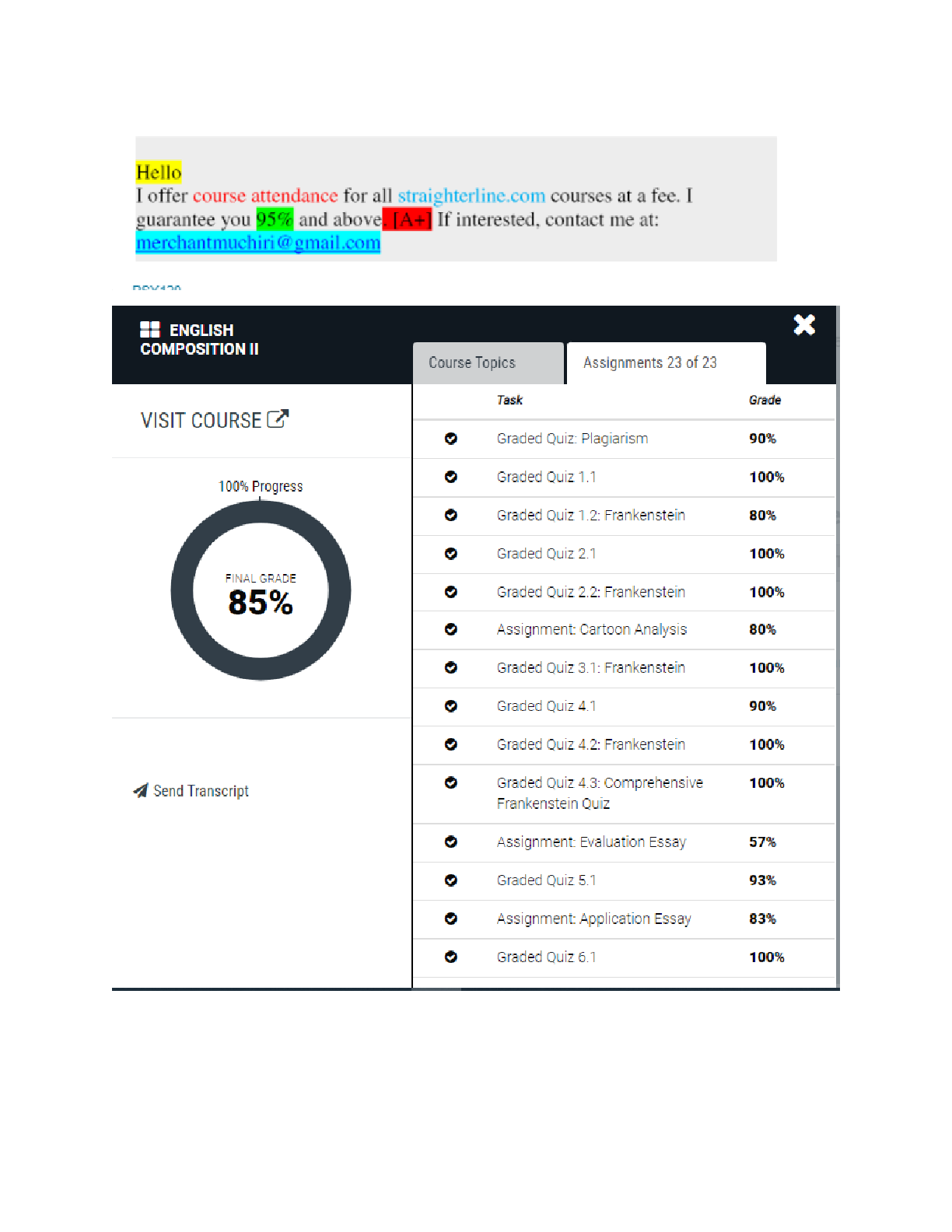
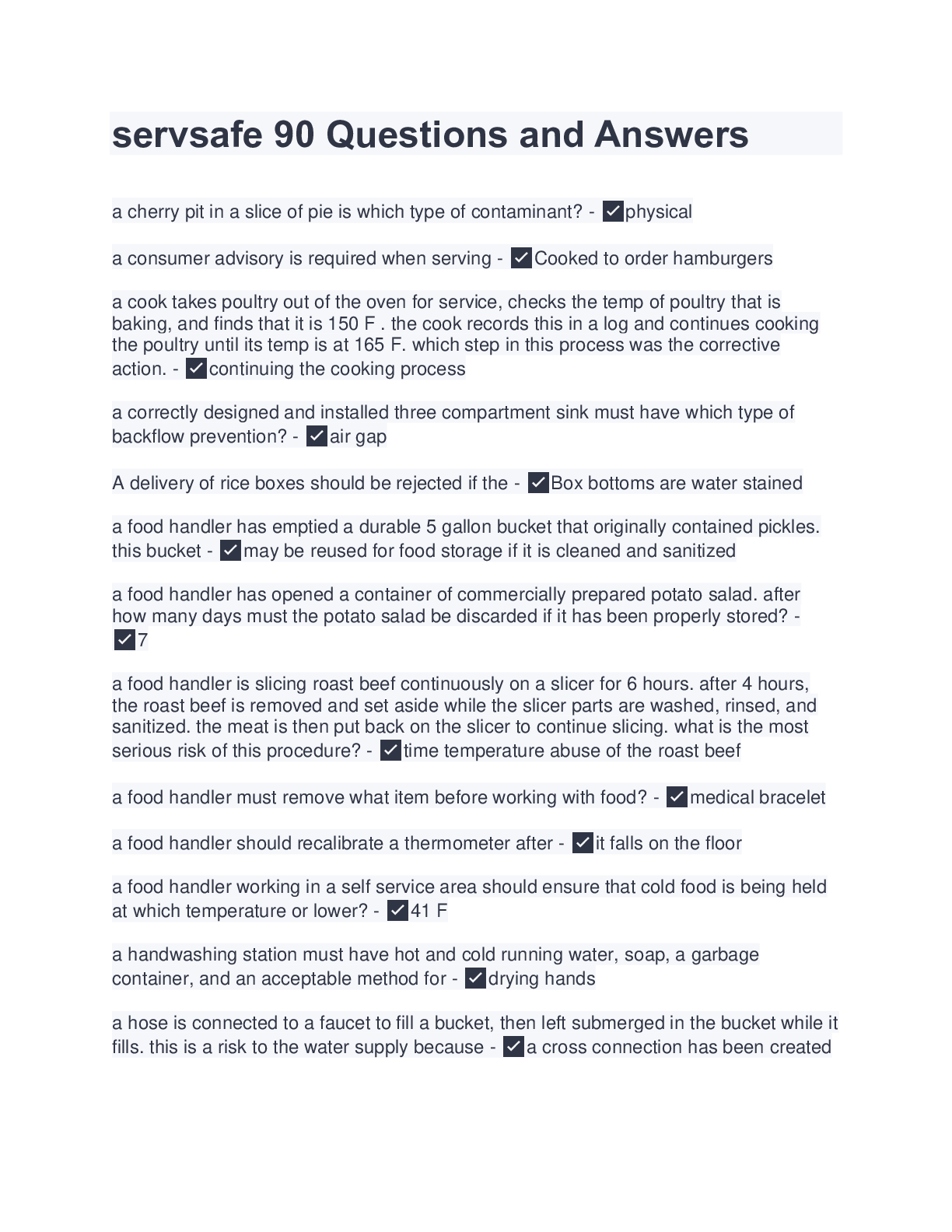
.png)


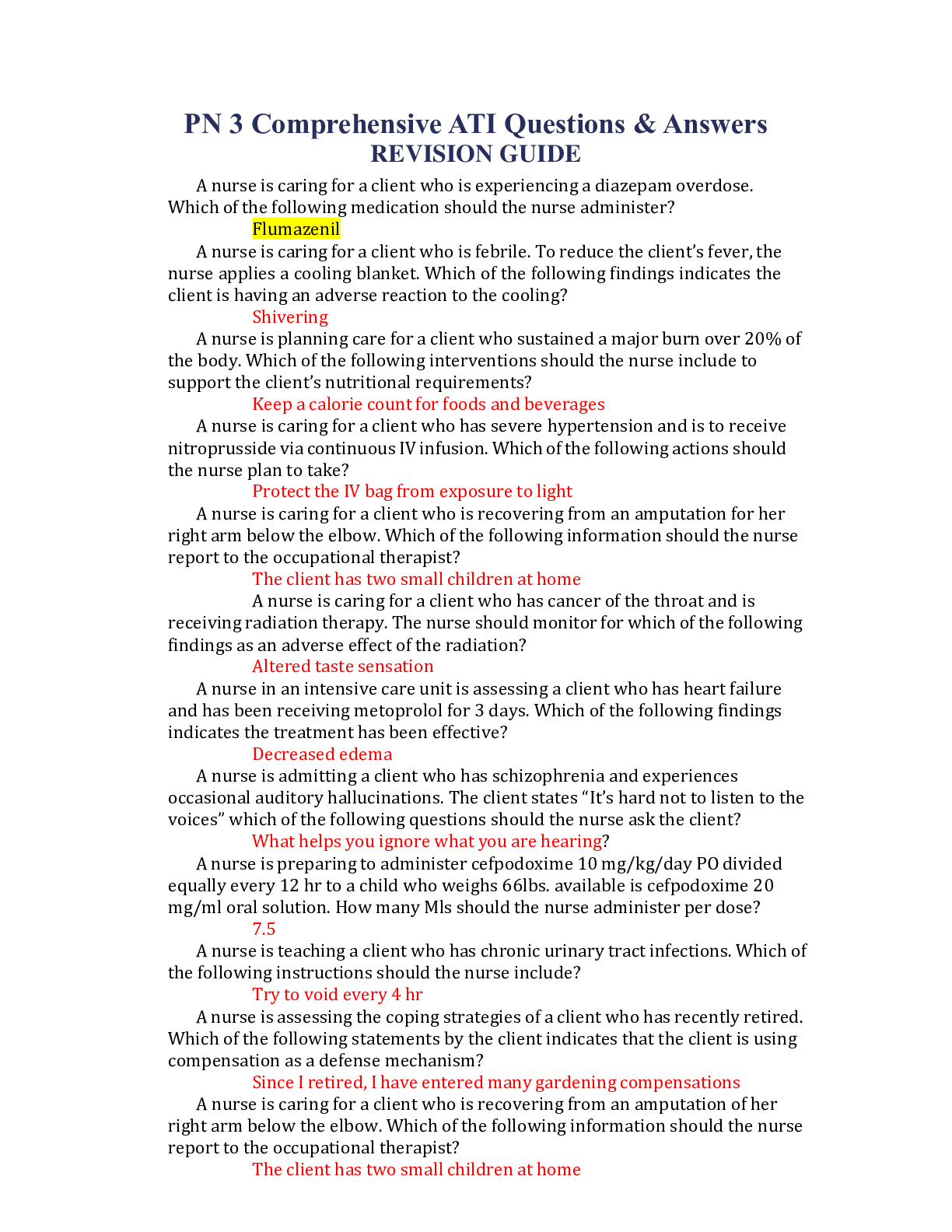
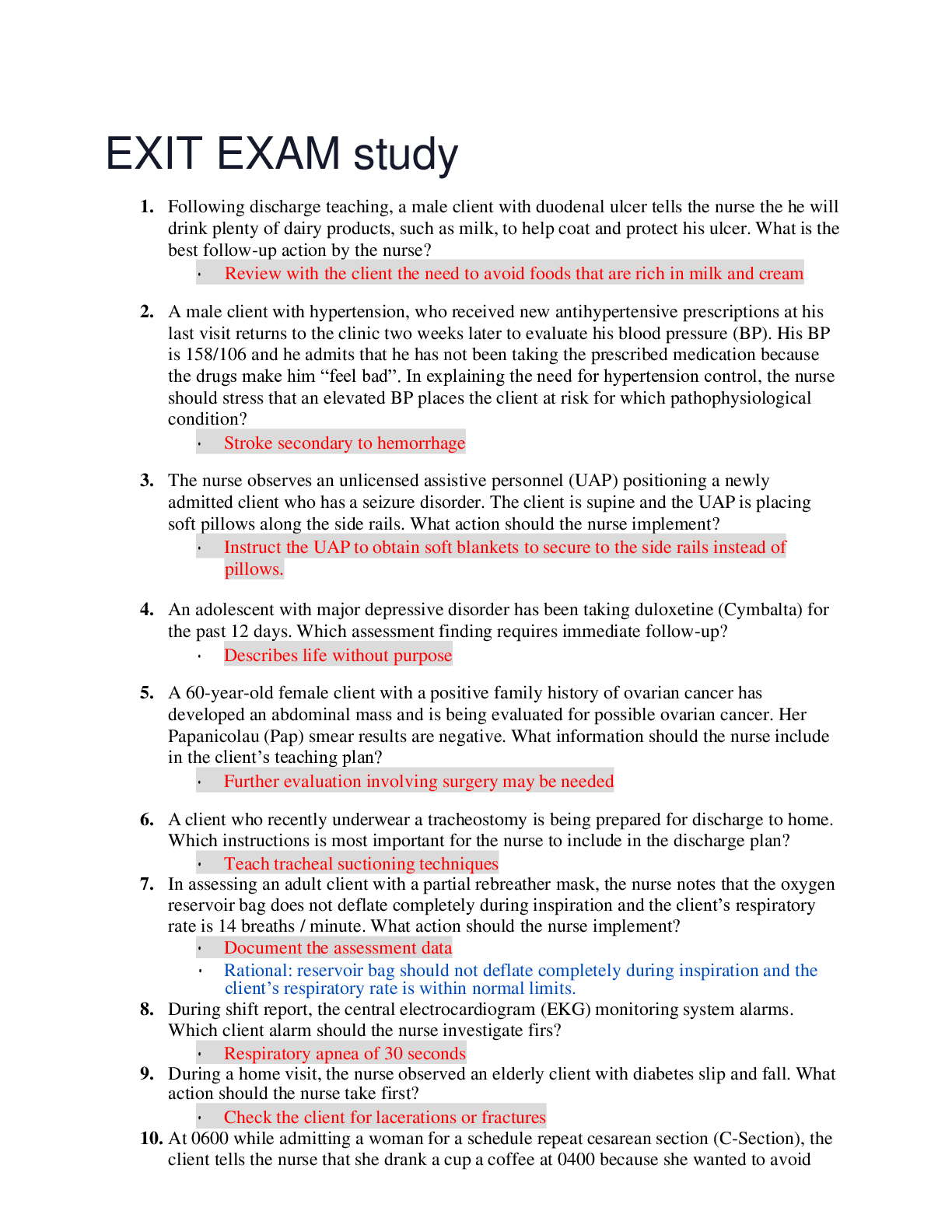
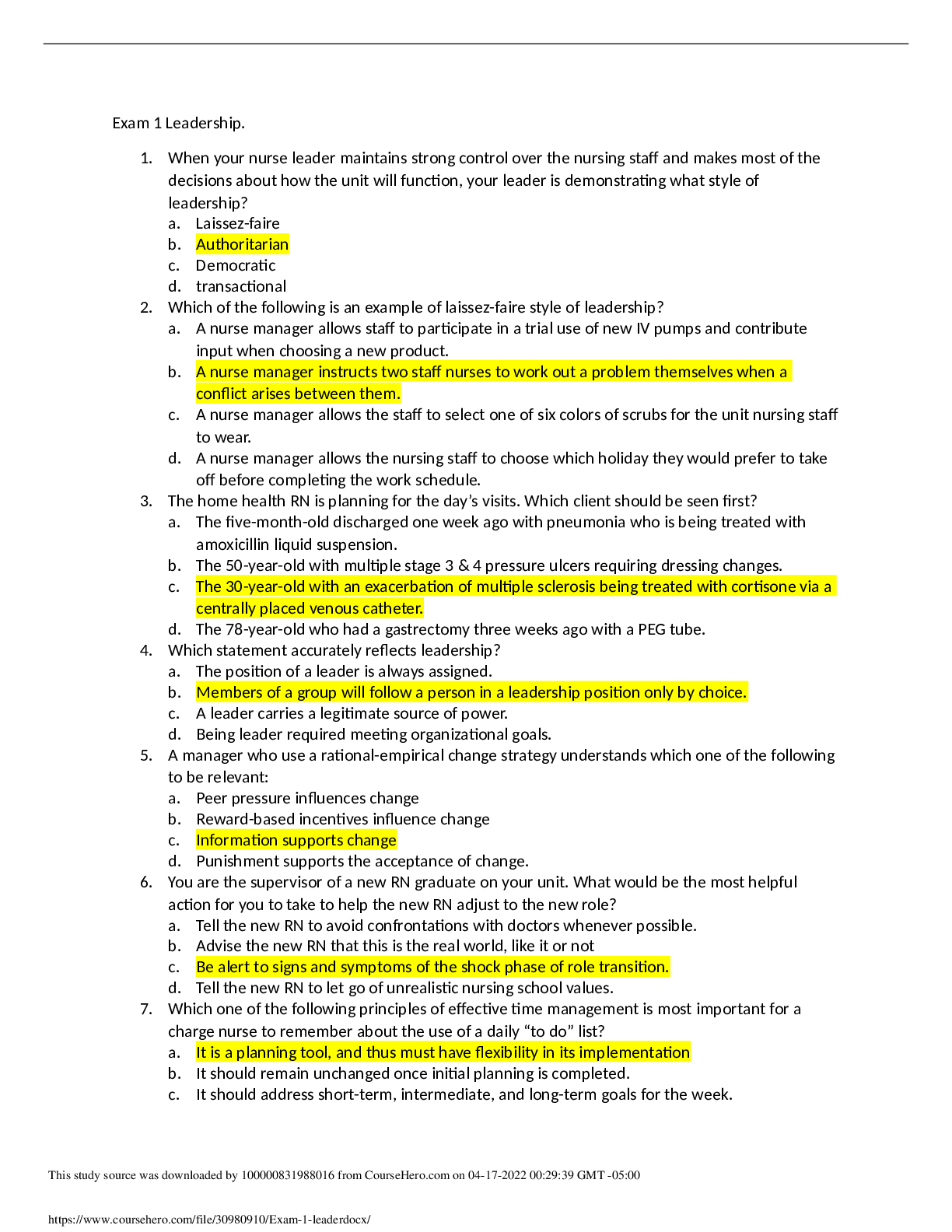
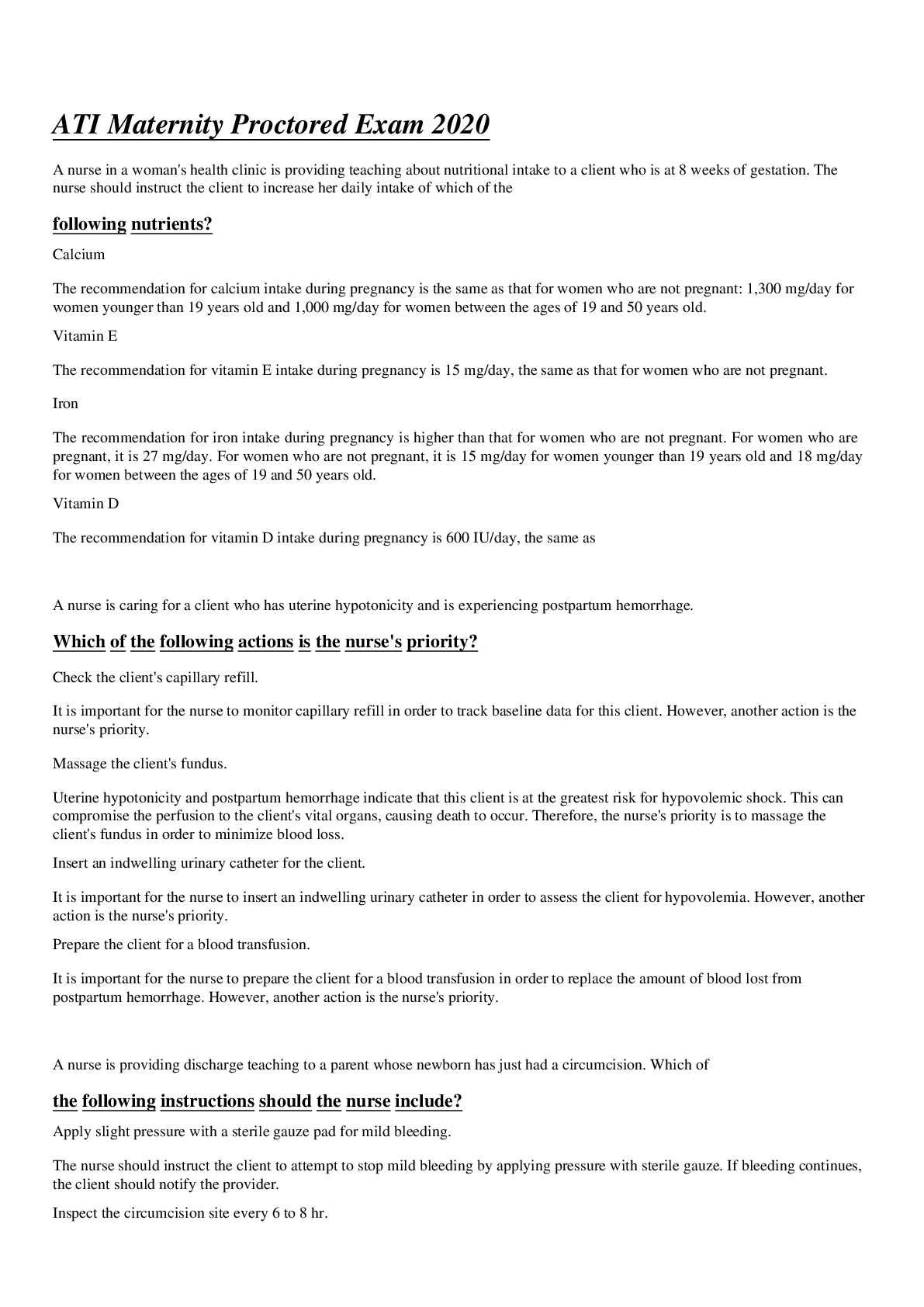
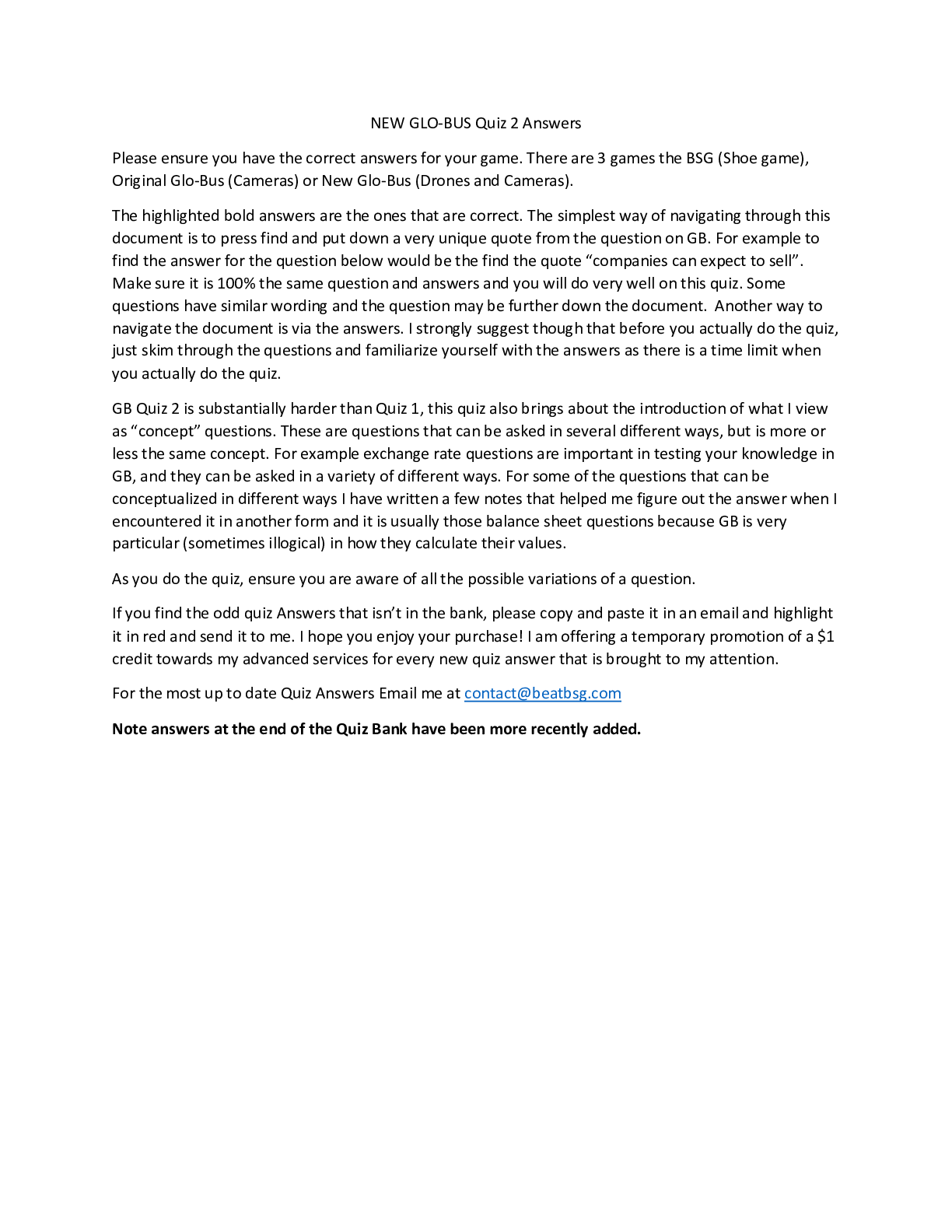
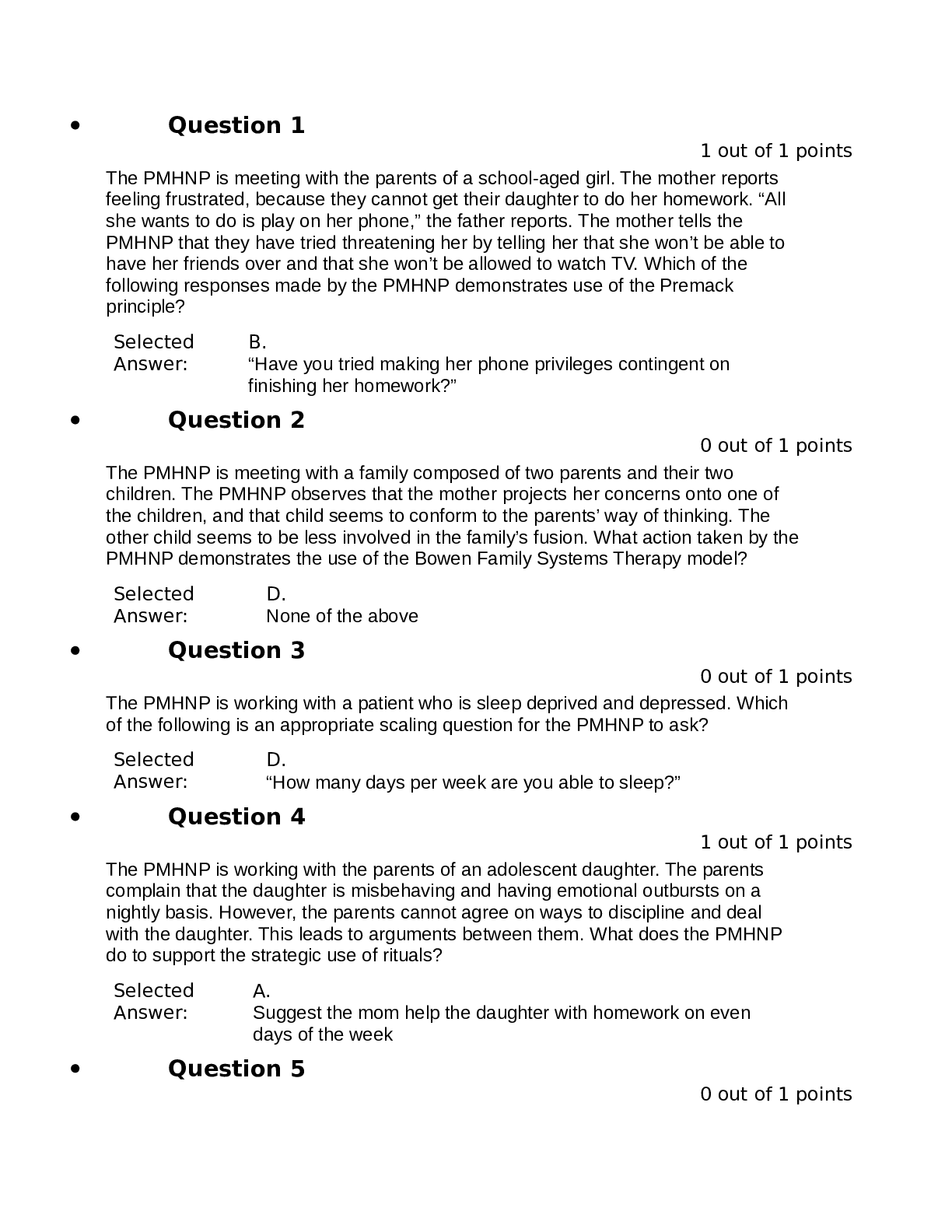
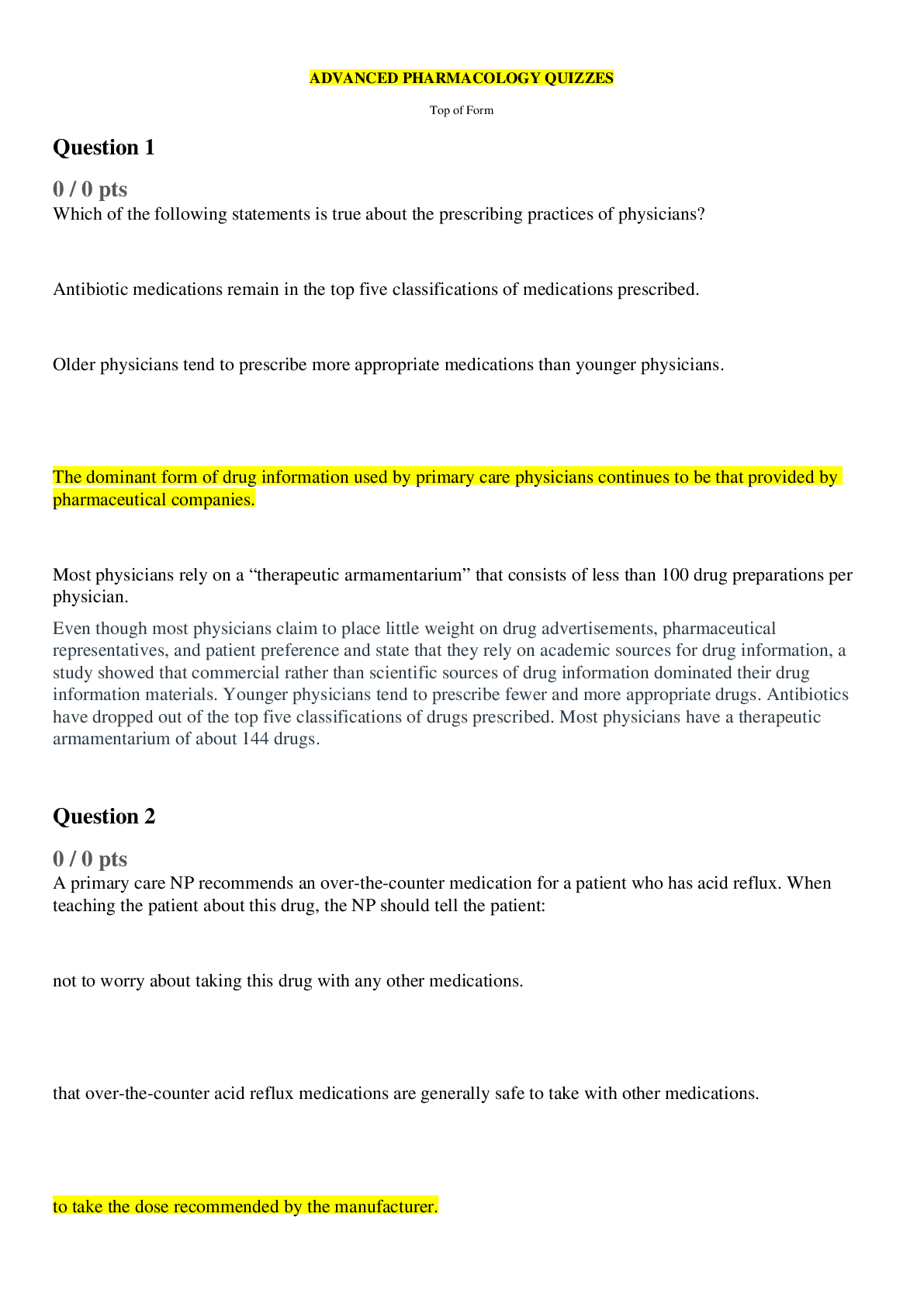
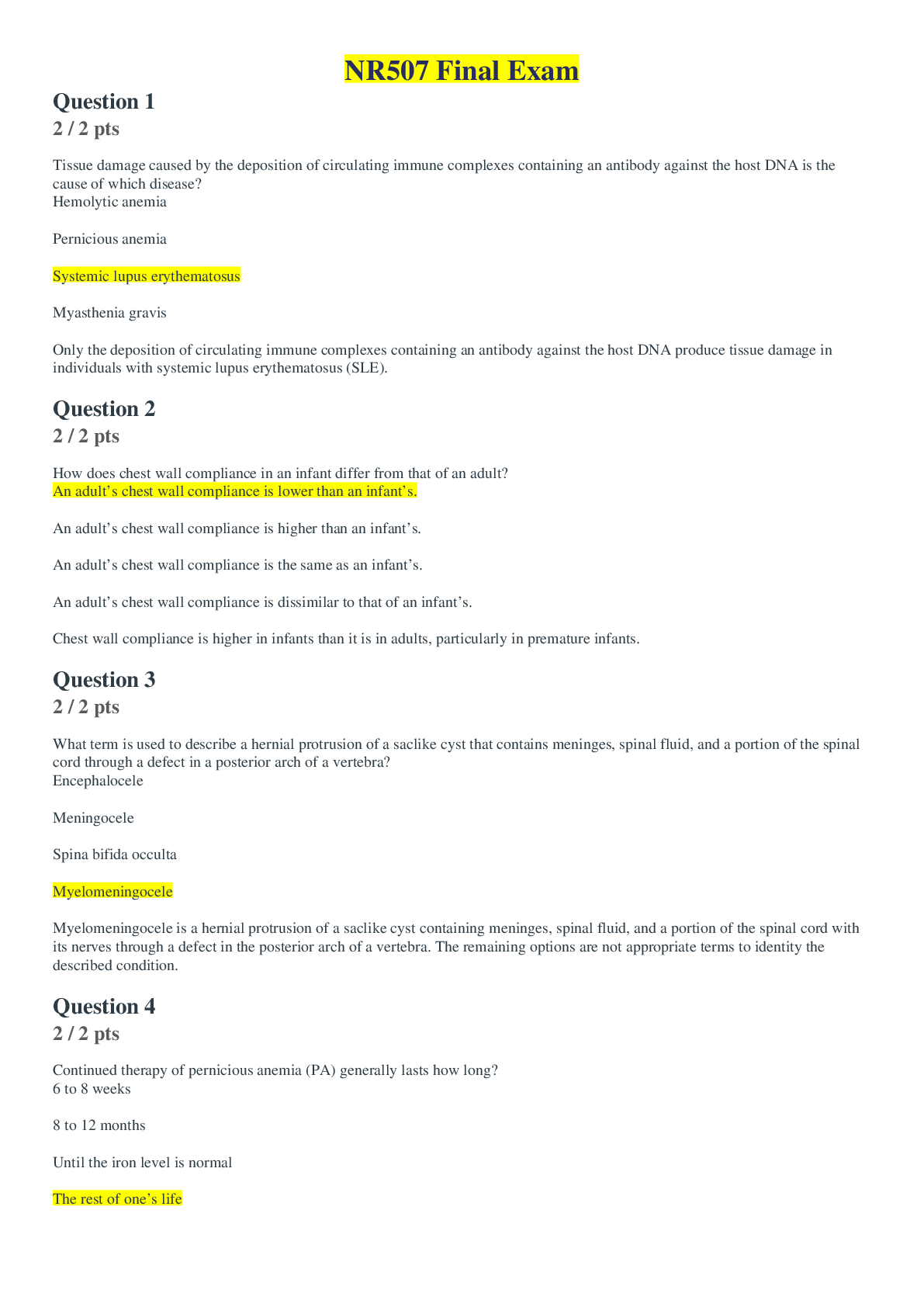
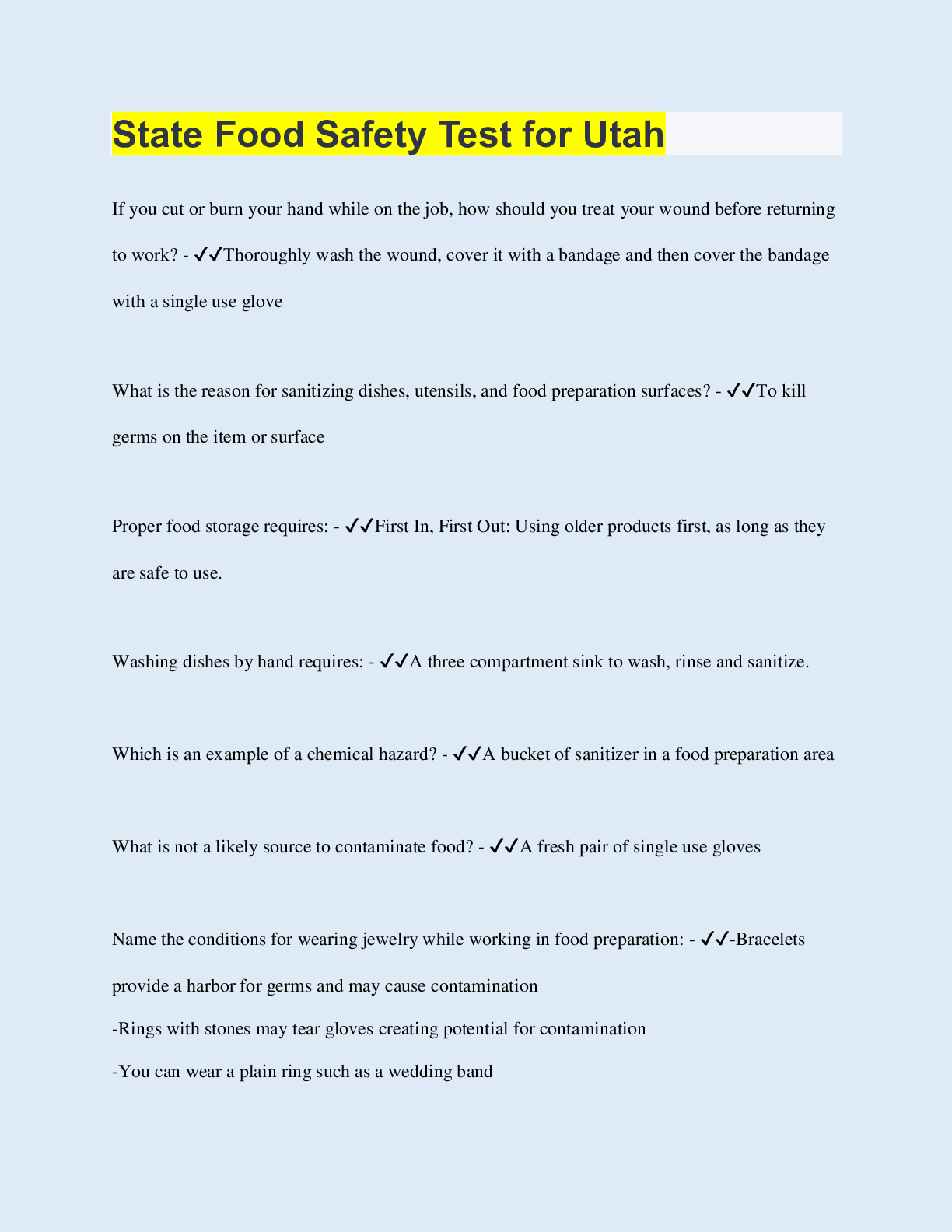

.png)

 (1).png)
